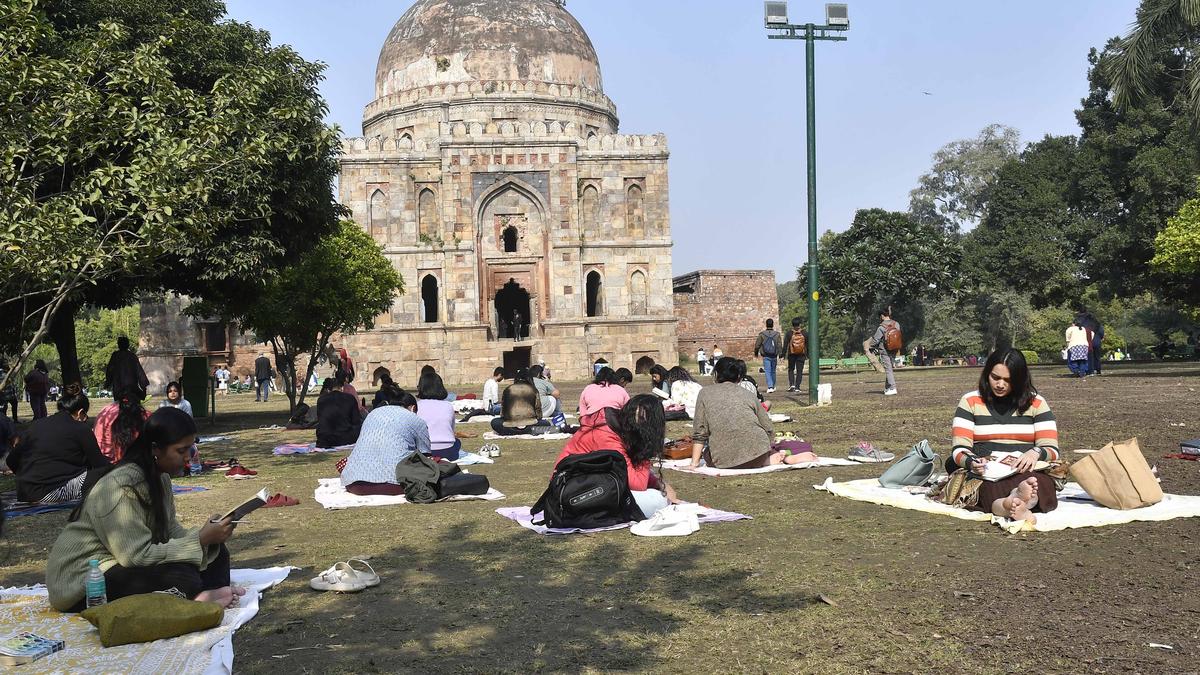
The landscape of Delhi is richly textured because of its gardens and their stories Premium
The Hindu
Discover the rich history of Mughal gardens in Delhi through books, from Babur to Shahjahan, in this insightful exploration by The Hindu
Each of the Mughals, from Babur to Aurangzeb, had a quality uniquely his own. Babur, the founder, was a lover of nature, and as Ebba Koch writes in The Planetary King, “a creator of gardens”. He is credited with having introduced in Hindustan the Timurid form of ‘char bagh’, the first such garden having come up in Agra, though the masses remember the city for the Taj Mahal with its manicured gardens and a majestic tomb. The Mughals often camped in tents in gardens on their travels throughout their empire. These gardens had flowers and fruit trees, fountains and pools.
Akbar, of course, was the millennial hero, and Jahangir had abiding interest in the topography and landscape of the empire. Then there was Humayun, the tragic king who is best remembered through the splendid tomb built by his senior wife Haji Begum, more than a decade after he breathed his last. Humayun’s last resting place was to define Delhi, a city where many a mosque stands in the middle of a garden, and many a tomb is surrounded by gardens. And each garden is separated from the other by a waterway. Haji Begum chose the site with care; the tomb was located opposite the dargah of the great sufi, Nizamuddin, and not far from Din Panah, the Abode of Faith, a city Humayun founded on the banks of the Yamuna.
As Catherine Asher writes in Architecture of Mughal India, the tomb probably had a hand of Akbar in it. In a concession to his Timurid roots, Akbar hired architects from Bukhara. The tomb was built by the Begum in ‘char bagh’ pattern, that is, four gardens all around the tomb with each garden being segregated with a neat waterway. Though many trace the design to the Sassanian era, most historians agree that it was associated with the Islamic notions of gardens in paradise wherein rivers are said to flow.
Interestingly, red sandstone and white marble were used for the tomb with the white colour being associated with Brahmins by many, and with Sufis by others. The colour red is associated with the warriors or Kshatriyas. Whether it was a concession to local sensitivity or a smart move to Indianise the dynasty, nobody will ever know.
Humayun is not as well remembered in history, but his tomb laid the template for tombs and gardens in Delhi, giving the city a unique appearance. Many years later, Humayun’s great-grandson Shahjahan built the lofty Jama Masjid in the city. Till three decades ago, the mosque had beautiful gardens around it, with one waterway of fountains, big and small, leading towards the eastern gate of the place of worship.
However, there is more to Delhi’s gardens, historic or otherwise, than their association with the Mughals. In their recent book, Gardens of Delhi, Swapna Liddle and Madhulika Liddle, recount, “The oldest garden of which some remains can still be found in Delhi, dates from the 14th century, when Delhi was ruled by the Tughlaq dynasty. Though the original horticulture of the garden has disappeared without a trace, we are lucky to have some physical remains of a terraced garden — probably the only such Tughlaq era garden in existence. It lies inside a DDA park called Vasant Udyan.”
Delhi’s durable bond with gardens continued after the Tughlaqs. It was indeed there before the Tughlaqs too. For instance, as the Liddles point out, there was Bagh-e-Jadd, a 13th century garden of bounty where the Sultan used to meet foreign emissaries. “What remains of the garden itself now goes by the name of Lodi Garden, which is next to Jor Bagh.” Back in the 13th century, this garden too would have had a steady stream flowing through it. Then in the 15th century came the Lodis, and the domes of Sheesh Gumbad and Bada Gumbad. The tombs and the gumbads were once again located in gardens. The association of canals and rivers in gardens with Nahar-e-Bahisht or the River of Paradise was as remarkable as it was intriguing. The Lodi Gardens are the preferred venue for many a Delhiite. Some use them for a morning walk, others for an afternoon meet, still others for moments of love and leisure after a hard day’s work. “At 90 acres and with a long history as a green space, Lodi Gardens is one of the best gardens in Delhi to see a wide variety of plant and tree species. These include everything from exotics like silver oak, red bottle brush, eucalyptus, southern magnolia to indigenous trees like sita ashok, neem, mango and jamun,” reveal the Liddles in the book which has some amazing photographs by Prabhas Roy.

The Karnataka government has drafted a comprehensive master plan for the integrated development of Kukke Subrahmanya temple, the State’s highest revenue-generating temple managed by the Hindu Religious Institutions and Charitable Endowments Department. The redevelopment initiative is estimated to cost around ₹254 crore and aims to enhance infrastructure and facilities for devotees.












